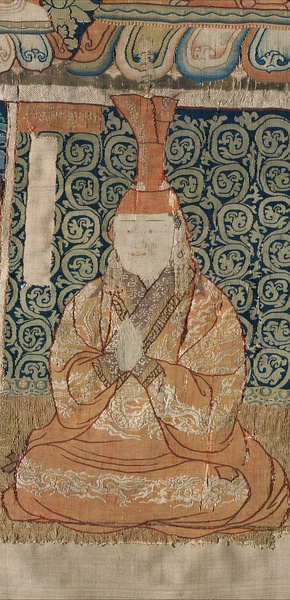Budashiri facts for kids
Quick facts for kids Budashiri |
|
|---|---|
 |
|
| Empress of China and Khatun of Mongols | |
| Tenure | 1328-1329 1329-1332 |
| Predecessor | Babukhan Khatun Babusha |
| Successor | Babusha Daliyetemishi |
| Born | c. 1307 |
| Died | c. 1340 |
| Spouse | Jayaatu Khan Tugh Temür |
| House | Khongirad |
| Father | Diwabala |
| Mother | Sengge Ragi of Lu |
Budashiri (born around 1307 – died around 1340) was a powerful woman in ancient China. She was an Empress of China and a Khatun of the Mongols. This means she was a queen, married to Jayaatu Khan Tugh Temür, an emperor of the Yuan dynasty.
Budashiri was also a regent for many years. A regent is someone who rules a country when the official ruler is too young or unable to do so. She was a regent from 1332 to 1339, first after her husband died, and then while her husband's successor was still a child.
She came from an important family called the Khongirad clan. Her father was Prince Consort Diwabala, and her mother was Princess Sengge Ragi.
Becoming Empress of Yuan China
We don't know exactly when Budashiri married Tugh Temür. But she became empress in 1328 when her husband became emperor for the first time. Early in 1329, she officially received the imperial seal, which was a symbol of her power.
During her husband's rule, Empress Budashiri made some big decisions. She sent a young prince named Toghon Temür away from the capital. First, she sent him to Goryeo (which is modern-day Korea), and then to Henan in China. She claimed he was not the true son of her husband's older brother, Khutughtu Khan Kusala. While Toghon Temür was away, Budashiri also arranged for his stepmother, Babusha, to be punished. Budashiri accused Babusha of plotting against her late husband.
Her Time as Regent
When Emperor Tugh Temür died in 1332, he had not named who should rule next. So, Budashiri became the regent, following the traditions of the time. It was said that her husband, before he died, felt bad about what he had done to his older brother. He wanted his nephew, Toghon Temür, to become the next emperor.
Because of this, Budashiri did not put her own son, El Tegüs, on the throne. But she also didn't immediately bring back Toghon Temür. Instead, she chose Kusala's second son, a six-year-old boy named Rinchinbal. He became emperor on October 13, 1332. The grand councilor, El Temür, put pressure on Budashiri to choose Rinchinbal. El Temür did not want Toghon Temür to become emperor because he was suspected of harming his own father.
A month after Rinchinbal became emperor, Budashiri was given the title of empress dowager. This meant she was the emperor's mother (or stepmother) and was in charge of ruling as regent. However, the young emperor Rinchinbal died just two months later.
El Temür then tried to convince Budashiri to make her son, El Tegüs, the emperor. But Budashiri refused. She said she was still honoring her late husband's wishes, and that El Tegüs was too young to rule. Instead, she brought back the thirteen-year-old Toghon Temür, and he became emperor in 1333. In 1336, Budashiri's title was raised to grand empress dowager, giving her even more respect.
Budashiri continued to rule as regent for more than seven years. She had great power over the empire. However, in 1340, Emperor Toghon Temür felt confident enough to take full control. He started looking into the unfair things that had happened to his father and stepmother. He also brought up the wrongs that the grand empress dowager had done to him.
As a result, in mid-1340, the emperor ordered that Budashiri lose all her titles. She was sent away to Dong'an Prefecture (which is now Langfang in Hebei Province), where she was swiftly put to death. She was about 33 years old when she died. To get back at those who caused him trouble, Emperor Toghon Temür also sent El Tegüs away, and he was killed soon after.
Family Life
It is believed that Empress Budashiri had at least three sons with Emperor Tugh Temür:
- Aratnadara (who died on February 22, 1331)
- Gunadara, later known as El Tegüs (born around 1329, died around 1340)
- Baoning, later known as Taipingna (who died young)
It is not known if she had any daughters.
In Art
A picture of Empress Budashiri, along with Empress Babusha, can be found on a special artwork called the Yamantaka-Vajrabhairava mandala. On the opposite side of this artwork are pictures of Tugh Temür and Kusala.

